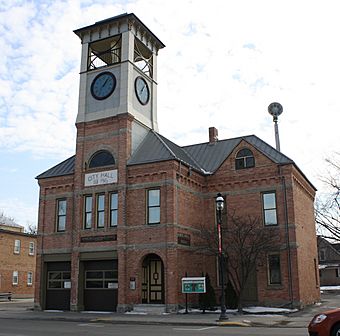Omro Village Hall and Engine House facts for kids
Quick facts for kids |
|
|
Omro Village Hall and Engine House
|
|

Omro Village Hall and Engine House
|
|
| Location | 144 E. Main St., Omro, Wisconsin |
|---|---|
| Built | 1896 |
| Architect | Fred G. Root |
| Architectural style | Queen Anne |
| NRHP reference No. | 97000327 |
| Added to NRHP | April 14, 1997 |
The Omro Village Hall and Engine House was built in 1896. It was the first main building for the local government in Omro, Wisconsin. For 70 years, it was the center of town activities. In 1997, it was added to the National Register of Historic Places. This happened because of its beautiful old design and its important role in the community's history.
Contents
Omro's Early Days
How Omro Started
The first person to settle in the area that became Omro was Edward West in 1845. By 1848, many other settlers had joined him. Most of them were farmers. Soon after, sawmills were built along the Fox River. In 1849, the village of Omro was officially planned out.
Growing into a Village
In 1857, Omro became an official village. This meant it had its own local government. More businesses opened up. Even more growth happened when the railroad arrived in 1861. By 1891, Omro had about 1,600 people living there.
A Home for the Fire Department
The First Fire Station
In 1891, the village leaders, called trustees, created a fire department. They bought a fire engine pulled by horses. They also got two hose carts that people pulled by hand. This fire equipment was expensive and needed a safe place. So, the trustees bought a small wooden building. This became Omro's first fire engine house. At that time, all the other village offices were in different places around town.
Building a New Hall
A few years later, in 1895, the village board decided to build a better building. It would be used for the fire department and other village needs. A local builder and architect named Fred Root designed the building in February 1896. Different companies offered to build it. By July, the building was ready to be used. Thomas Thompson was the contractor for the stone and brick work. Stanton, Lillicrap, and Root handled the carpentry. The whole building cost $5,000 to build.
Design and Features
What the Building Looks Like
The Omro Village Hall sits on a strong stone foundation. Its walls are made of pink brick and rise two stories high. The roof is a hip roof, which means it slopes on all four sides. It still has its original metal covering. A tall, square tower rises two more stories above the main building. This tower has a clock on all four sides, made by the famous Seth Thomas Clock Company.
The Bell and Its Style
Above the clock, there is an open area called a belfry. This belfry holds the original bronze fire bell, which weighs 900 pounds! The building's tall look, its uneven shape, and the different textures of its walls are common features. These are typical of the Queen Anne architectural style.
Inside the Hall
On the first floor, large garage doors led to the engine room. This is where the fire department kept its equipment. To the west, a front room was first used as the village jail. Later, it became the public library. A straight staircase goes up to the second floor. This floor has three rooms. One room was the office for the village clerk. The clerk is like a secretary for the village government. This office had a strong walk-in vault to keep important papers safe.
Later Years and Today
The 1896 village hall and engine house was used until 1966. Most of its government jobs then moved to the Omro Theatre building. After that, some people wanted to tear down the old building to make more parking spaces. But the town voted against it in a special election, called a referendum. Instead, the building was used by some community groups until 1981. Since then, the Omro Area Historical Society has used it. Today, it serves as a museum, helping people learn about Omro's past.

